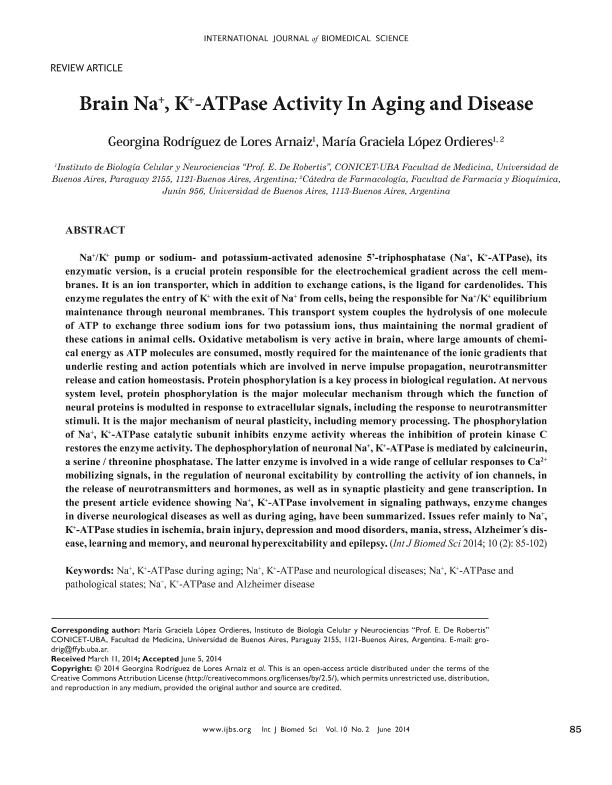Artículo
Brain Na+, K+-ATPase activity In aging and disease
Fecha de publicación:
07/2014
Editorial:
Master Publishing Group
Revista:
International Journal of Biomedical Science
ISSN:
1550-9702
Idioma:
Inglés
Tipo de recurso:
Artículo publicado
Clasificación temática:
Resumen
Na+/K+ pump or sodium- and potassium-activated adenosine 5’-triphosphatase (Na+, K+-ATPase), its enzymatic version, is a crucial protein responsible for the electrochemical gradient across the cell membranes. It is an ion transporter, which in addition to exchange cations, is the ligand for cardenolides. This enzyme regulates the entry of K+ with the exit of Na+ from cells, being the responsible for Na+/K+ equilibrium maintenance through neuronal membranes. This transport system couples the hydrolysis of one molecule of ATP to exchange three sodium ions for two potassium ions, thus maintaining the normal gradient of these cations in animal cells. Oxidative metabolism is very active in brain, where large amounts of chemical energy as ATP molecules are consumed, mostly required for the maintenance of the ionic gradients that underlie resting and action potentials which are involved in nerve impulse propagation, neurotransmitter release and cation homeostasis. Protein phosphorylation is a key process in biological regulation. At nervous system level, protein phosphorylation is the major molecular mechanism through which the function of neural proteins is modulted in response to extracellular signals, including the response to neurotransmitter stimuli. It is the major mechanism of neural plasticity, including memory processing. The phosphorylation of Na+, K+-ATPase catalytic subunit inhibits enzyme activity whereas the inhibition of protein kinase C restores the enzyme activity. The dephosphorylation of neuronal Na+, K+-ATPase is mediated by calcineurin, a serine / threonine phosphatase. The latter enzyme is involved in a wide range of cellular responses to Ca2+ mobilizing signals, in the regulation of neuronal excitability by controlling the activity of ion channels, in the release of neurotransmitters and hormones, as well as in synaptic plasticity and gene transcription. In the present article evidence showing Na+, K+-ATPase involvement in signaling pathways, enzyme changes in diverse neurological diseases as well as during aging, have been summarized. Issues refer mainly to Na+, K+-ATPase studies in ischemia, brain injury, depression and mood disorders, mania, stress, Alzheimer´s disease, learning and memory, and neuronal hyperexcitability and epilepsy.
Archivos asociados
Licencia
Identificadores
Colecciones
Articulos(IBCN)
Articulos de INST.DE BIOLO.CEL.Y NEURCS."PROF.E.DE ROBERTIS"
Articulos de INST.DE BIOLO.CEL.Y NEURCS."PROF.E.DE ROBERTIS"
Citación
Rodriguez, Georgina Emma; López Ordieres, María Graciela; Brain Na+, K+-ATPase activity In aging and disease; Master Publishing Group; International Journal of Biomedical Science; 10; 2; 7-2014; 85-102
Compartir
Items relacionados
Mostrando titulos relacionados por título, autor y tema.
-
Artículo Neurotensin inhibits neuronal Na+, K+-ATPase activity through high affinity peptide receptorLópez Ordieres, María Graciela; Rodriguez, Georgina Emma (Elsevier Science Inc, 2000-03)
-
Montes, Monica Raquel ; Ferreira Gomes, Mariela Soledad ; Centeno, Mercedes; Rossi, Rolando Carlos (Elsevier Science, 2015-07)
-
Mangialavori, Irene Cecilia ; Montes, Monica Raquel ; Rossi, Rolando Carlos ; Fedosova, Natalya U.; Rossi, Jean Paul F.C. (Elsevier Science, 2011-04)




